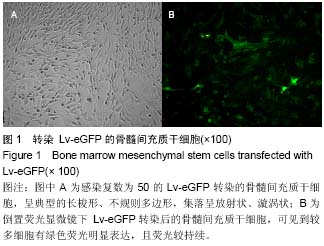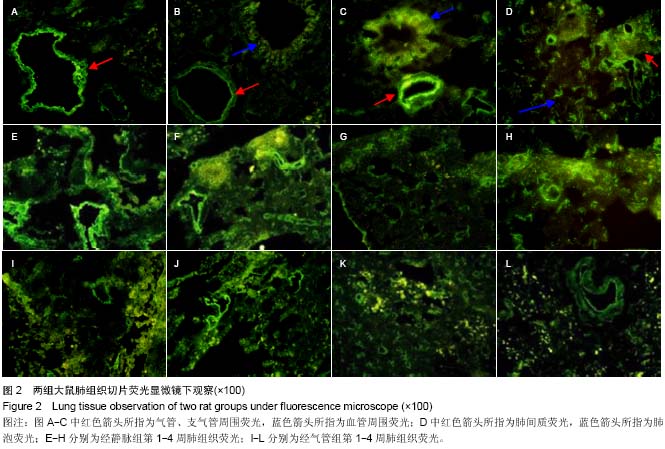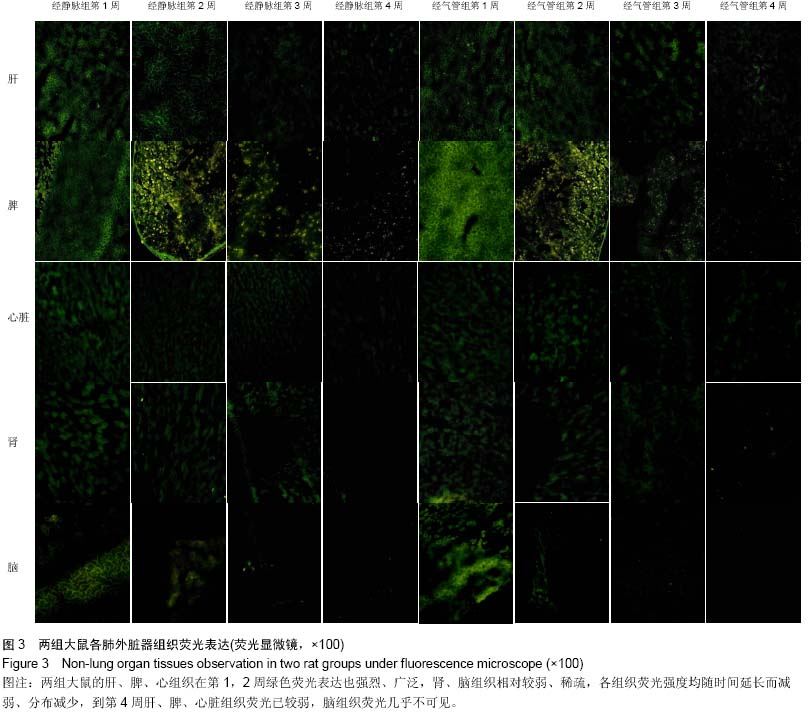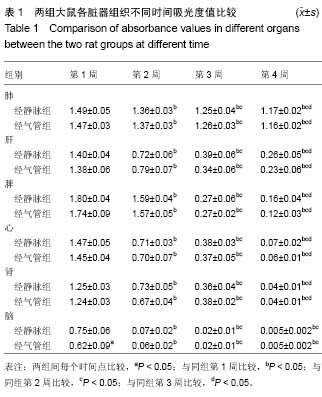中国组织工程研究 ›› 2015, Vol. 19 ›› Issue (28): 4562-4566.doi: 10.3969/j.issn.2095-4344.2015.28.024
• 干细胞移植 stem cell transplantation • 上一篇 下一篇
不同方式移植骨髓间充质干细胞在染矽尘大鼠体内的归巢
黄 明,周永梅,燕 玲,李 斌,吴奇峰,梁伟辉
- 广东省职业病防治院,广东省广州市 510300
-
出版日期:2015-07-02发布日期:2015-07-02 -
作者简介:黄明,女,1980年生,湖南省平江县人,汉族,2010年南方医科大学毕业,博士,副主任医师,主要从事职业病防治研究。 -
基金资助:国家自然科学基金项目(81302396);国家十二五科技支撑计划项目分课题(2014BAI12B01);广东省职业病防治重点实验室(2012A061400007);广东省医学科研基金(2015年)
In vivo homing of bone marrow mesenchymal stem cells transplanted through different ways in rats exposed to silica dust
Huang Ming, Zhou Yong-mei, Yan Ling, Li Bin, Wu Qi-feng, Liang Wei-hui
- Guangdong Province Hospital for Occupational Disease Prevention and Treatment, Guangzhou 510300, Guangdong Province, China
-
Online:2015-07-02Published:2015-07-02 -
About author:Huang Ming, M.D., Associate chief physician, Guangdong Province Hospital for Occupational Disease Prevention and Treatment, Guangzhou 510300, Guangdong Province, China -
Supported by:the National Natural Science Foundation of China, No. 81302396; the National Science and Technology Support Program of China during the 12th Five-Year Period, No. 2014BAI12B01; the Project of Guangdong Provincial Key Laboratory of Occupational Disease Prevention, No. 2012A061400007; Guangdong Medical Research Foundation in 2015
摘要:
背景:骨髓间充质干细胞植入染矽尘大鼠体内能归巢到受损肺部,但何种植入途径在体内的归巢效果更好尚不清楚。 目的:动态比较观察不同途径移植骨髓间充质干细胞在染矽尘大鼠体内的分布情况。 方法:全骨髓贴壁法分离、培养供体大鼠骨髓间充质干细胞,用携带增强型绿色荧光蛋白基因的慢病毒(Lv-eGFP)转染骨髓间充质干细胞。受体大鼠用气管内注入法染尘,再随机分为经静脉组和经气管组,将转染Lv-eGFP的骨髓间充质干细胞分别经静脉、气管途径注入大鼠体内,在移植后的第1,2,3,4周处死大鼠,取心、肝、脾、肺、肾、脑组织进行冰冻切片,荧光显微镜下观察荧光,图文分析软件计算荧光强度。 结果与结论:两组大鼠肺组织均可见强烈、分布广泛且持续的绿色荧光,尤以气管、血管周围明显;两组荧光强度均随时间延长呈轻度减低趋势,但两组每周的荧光强度差异无显著性意义(P > 0.05)。两组大鼠其余各脏器早期也均可见荧光,其中肝、脾、心脏组织荧光强、分布广,肾、脑组织荧光相对较弱、分布较稀疏;随时间推移,各组织荧光均逐渐减弱,面积逐渐减少,到后期仅肝、脾组织可见到较弱、散在荧光分布,脑组织荧光几乎不可见。在同一时间点,两组除第1周脑组织荧光强度差异有显著性意义(P < 0.05)外,其余差异均无显著性意义(P > 0.05)。提示骨髓间充质干细胞经静脉和气管两种途径植入染矽尘大鼠体内归巢至受损肺部的效率相当。 中国组织工程研究杂志出版内容重点:干细胞;骨髓干细胞;造血干细胞;脂肪干细胞;肿瘤干细胞;胚胎干细胞;脐带脐血干细胞;干细胞诱导;干细胞分化;组织工程
中图分类号:
引用本文
黄 明,周永梅,燕 玲,李 斌,吴奇峰,梁伟辉. 不同方式移植骨髓间充质干细胞在染矽尘大鼠体内的归巢[J]. 中国组织工程研究, 2015, 19(28): 4562-4566.
Huang Ming, Zhou Yong-mei, Yan Ling, Li Bin, Wu Qi-feng, Liang Wei-hui . In vivo homing of bone marrow mesenchymal stem cells transplanted through different ways in rats exposed to silica dust[J]. Chinese Journal of Tissue Engineering Research, 2015, 19(28): 4562-4566.

2.1 Lv-eGFP转染骨髓间充质干细胞效果 从供体大鼠骨髓分离、培养、增殖、传代获得较高纯度的骨髓间充质干细胞。用Lv-eGFP转染骨髓间充质干细胞48 h后,荧光显微镜下可见到绿色荧光表达,在72-96 h达到高峰,之后荧光趋于稳定。按前期实验方法,采用不同感染复数的Lv-eGFP转染骨髓间充质干细胞,当感染复数为50时,细胞转染率达80%,且转染与未转染Lv-eGFP的骨髓间充质干细胞生长状态均良好(图1),存活率和每日增殖率差异均无显著性意义(P > 0.05),故采用感染复数为50的Lv-eGFP转染骨髓间充质干细胞。


2.4 两组大鼠肺外组织荧光表达 两组大鼠除肺组织外的其他组织在第1周的荧光也较明显,其中尤以肝、脾和心脏组织荧光强烈、分布广泛,脑和肾脏组织荧光则相对较弱且分布相对稀疏;但两组上述各组织荧光表达强度及范围在荧光显微镜下肉眼观察并未发现有明显差别。经静脉组和经气管组大鼠的上述各组织荧光强度随时间延长而逐渐减弱,分布面积也逐渐减少,到第4周仅肝脏和脾脏组织切片中可见到较弱的散在荧光分布,心脏、肾脏组织荧光更趋微弱,而脑组织切片的荧光则几乎不可见;荧光显微镜下观察上述组织的荧光强度及面积在两组大鼠间并无明显差异,见图3。

| [1] 周永梅,黄明,燕玲,等.骨髓间充质干细胞在染矽尘大鼠体内示踪研究[J].中国职业医学,2015,42(2):128-135. [2] 黄明,周永梅,宋向荣,等.骨髓间充质干细胞对染矽尘大鼠肺损伤修复作用研究[J].中国职业医学, 2014,41(4):361-366. [3] 黄明,周永梅,李斌,等.经气管移植骨髓间充质干细胞在染矽尘大鼠体内的归巢[J].中国组织工程研究,2015,19(23):3711-3715. [4] 中国疾病预防控制中心职业卫生与中毒控制所. 关于实验性尘肺研究问题的访谈[J].中华劳动卫生职业病杂志,2010,28(1): 1-2. [5] De Miguel MP, Fuentes-Julián S, Blázquez-Martínez A, et al. Immunosuppressive properties of mesenchymal stem cells: advances and applications. Curr Mol Med. 2012;12(5): 574-591. [6] Tsai HL, Chang JW, Yang HW, et al. Amelioration of paraquat-induced pulmonary injury by mesenchymal stem cells. Cell Transplant. 2013;22(9):1667-1681. [7] Shen Q, Chen B, Xiao Z, et al. Paracrine factors from mesenchymal stem cells attenuate epithelial injury and lung fibrosis. Mol Med Rep. 2015;11(4):2831-2837. [8] Berry SE. Concise review: mesoangioblast and mesenchymal stem cell therapy for muscular dystrophy: progress, challenges, and future directions. Stem Cells Transl Med. 2015;4(1):91-98. [9] Hashemi SM, Ghods S, Kolodgie FD, et al. A placebo controlled, dose-ranging, safety study of allogenic mesenchymal stem cells injected by endomyocardial delivery after an acute myocardial infarction. Eur Heart J. 2008;29(2): 251-259. [10] Karp JM, Leng Teo GS. Mesenchymal stem cell homing: the devil is in the details. Cell Stem Cell. 2009;4(3):206-216. |
| [1] | 姜 涛, 马 磊, 李志强, 寿 玺, 段明军, 吴 硕, 马 创, 魏 琴. 血小板衍生生长因子BB诱导骨髓间充质干细胞向血管内皮细胞分化[J]. 中国组织工程研究, 2021, 25(25): 3937-3942. |
| [2] | 陈 扬, 黄邓高, 高元慧, 王顺兰, 曹 卉, 郑琳麟, 何浩伟, 罗思琴, 肖敬川, 张应爱, 张淑芳. 低强度脉冲场超声促进人脂肪间充质干细胞的增殖和黏附[J]. 中国组织工程研究, 2021, 25(25): 3949-3955. |
| [3] | 张立书, 刘安琪, 何小宁, 金 岩, 李 蓓, 金 钫. Alpl基因影响骨髓间充质干细胞治疗溃疡性结肠炎[J]. 中国组织工程研究, 2021, 25(25): 3970-3975. |
| [4] | 阮光萍, 姚 翔, 刘高米洋, 蔡学敏, 李自安, 庞荣清, 王金祥, 潘兴华. 脐带间充质干细胞移植治疗树鼩创伤性全身炎症反应综合征[J]. 中国组织工程研究, 2021, 25(25): 3994-4000. |
| [5] | 莫剑玲, 何少茹, 冯博文, 简敏桥, 张晓晖, 刘财盛, 梁一晶, 刘玉梅, 陈 亮, 周海榆, 刘艳辉. 构建预血管化细胞膜片及血管形成相关因子的表达[J]. 中国组织工程研究, 2021, 25(22): 3479-3486. |
| [6] | 陈 磊, 郑 蕊, 杰永生, 綦 惠, 孙 磊, 舒 雄. 脂肪血管基质成分复合骨软骨一体化支架的体外评价[J]. 中国组织工程研究, 2021, 25(22): 3487-3492. |
| [7] | 魏 琴, 张 雪, 马 磊, 李志强, 寿 玺, 段明军, 吴 硕, 贾麒钰, 马 创. 血小板衍生生长因子BB诱导大鼠骨髓间充质干细胞向成骨细胞分化[J]. 中国组织工程研究, 2021, 25(19): 2953-2957. |
| [8] | 陈 晓, 郭 智, 陈丽娜, 刘玄勇, 张弋慧智, 李旭绵, 王月乔, 韦丽娅, 谢 晶, 蔺 莉. 自体外周血造血干细胞动员采集的影响因素[J]. 中国组织工程研究, 2021, 25(19): 2958-2962. |
| [9] | 郭志斌, 吴春芳, 刘子洪, 张钰英, 迟博婧, 王 宝, 马 超, 张国彬, 田发明. 辛伐他汀可刺激骨髓间充质干细胞的成骨分化[J]. 中国组织工程研究, 2021, 25(19): 2963-2968. |
| [10] | 李聪聪, 姚 楠, 黄丹娥, 宋 敏, 彭 莎, 李安安, 卢 超, 刘文刚. 人髌下脂肪垫干细胞的鉴定及成软骨分化[J]. 中国组织工程研究, 2021, 25(19): 2976-2981. |
| [11] | 高元慧, 向 杨, 曹 卉, 王顺兰, 郑琳麟, 何浩伟, 张应爱, 张淑芳, 黄邓高. 两种月龄近交系五指山小型猪脂肪间充质干细胞生物学特性的比较[J]. 中国组织工程研究, 2021, 25(19): 2988-2993. |
| [12] | 曹 阳, 张军平, 彭 立, 丁 义, 李光辉. 兔主动脉内皮细胞的分离培养及生物学特性[J]. 中国组织工程研究, 2021, 25(19): 3000-3003. |
| [13] | 代 敏, 王 帅, 张霓霓, 黄桂林, 余丽梅, 胡小华, 易 杰, 姚 礼, 张立刚. 低氧预处理人羊膜间充质干细胞的生物学特征[J]. 中国组织工程研究, 2021, 25(19): 3004-3008. |
| [14] | 覃艳春, 荣 震, 蒋锐沅, 付 彬, 洪晓华, 莫春梅. 中药复方制剂抑制CD133+肝癌干细胞增殖及干性转录因子的表达[J]. 中国组织工程研究, 2021, 25(19): 3016-3023. |
| [15] | 戴雅玲, 陈乐文, 何肖君, 林华伟, 贾微微, 陈立典, 陶 静, 柳维林. miR-146b过表达慢病毒载体构建及对海马神经干细胞增殖的影响[J]. 中国组织工程研究, 2021, 25(19): 3024-3030. |
中国组织工程研究杂志出版内容重点:干细胞;骨髓干细胞;造血干细胞;脂肪干细胞;肿瘤干细胞;胚胎干细胞;脐带脐血干细胞;干细胞诱导;干细胞分化;组织工程
设计:随机对照动物实验。
时间及地点:实验于2014年10月至2015年2月在南方医科大学南方医院动物实验中心完成。
材料:
实验动物:健康SPF级SD雄性大鼠购自南方医科大学动物实验中心。骨髓间充质干细胞供体大鼠3只,4-6周龄,雄性,体质量120-150 g;受体大鼠8只,7-8周龄,雄性,体质量180-220 g。
|
骨髓间充质干细胞在染矽尘大鼠体内归巢实验所用主要试剂和仪器:
|
|
|
试剂和仪器
|
来源
|
|
SiO2粉尘
|
Sigma公司
|
|
特级胎牛血清、DMEM-LG培养基、胰酶
|
Gibco公司
|
|
Lv-eGFP试剂盒
|
Cyagen公司
|
|
CCK-8试剂盒
|
日本同仁化学试剂研究所
|
|
Jung冰冻包埋剂、恒温箱冷冻机
|
Leica公司
|
|
倒置相差荧光显微镜
|
Olympus公司
|
实验方法:
骨髓间充质干细胞分离培养:参照课题组前期实验全骨髓贴壁培养法取供体大鼠进行骨髓间充质干细胞分离培养、传代和鉴定[2]。
Lv-eGFP转染骨髓间充质干细胞:按课题组前期实验方法转染骨髓间充质干细胞[1,3],并对间充质干细胞进行细胞活力、增殖能力检测。
动物造模、分组:受体大鼠参照文献[4]方法,经气管内注入40 g/L的无菌SiO2粉尘混悬液1 mL造模,再将大鼠随机分为经静脉组和经气管组,每组4只。
骨髓间充质干细胞移植:造模后第2日按不同分组,分别经静脉和经气管途径将细胞浓度为5×109 L-1的Lv-eGFP转染的骨髓间充质干细胞0.5 mL注入到大鼠体内。
组织荧光观察:两组大鼠分别于植入Lv-eGFP转染骨髓间充质干细胞后第1,2,3,4周,统一放血处死大鼠,取肺、肝、脾、心、肾和脑组织经冰冻包埋剂包埋,保存于液氮管中,恒温箱冷冻机对各组织多部位快速冰冻切片,荧光显微镜下观察各组织切片的荧光表达。
荧光强度检测:荧光显微镜下随机选取5个视野,采集图像,Image-pro plus 6.0图文分析软件计算各组织的荧光光密度(即吸光度,A)值。
主要观察指标:绿色荧光表达的强度。
统计学分析:计量资料经正态性检验均符合正态分布,结果用x(_)±s表示。采用SPSS 19.0软件统计,析因设计资料采用析因设计方差分析;两组组间均数比较采用独立样本t检验;多组组间均数比较采用单因素方差分析,检验水准α=0.05。
间充质干细胞进入机体后,在趋化因子、黏附因子等细胞因子及受体介导下,具有向靶组织定向迁移、定植即归巢的能力,尤其在组织损伤及炎症情况下[9]。间充质干细胞归巢到受损部位后再进一步分化为组织细胞发挥修复作用。研究显示间充质干细胞如何发挥良好的损伤修复作用与其归巢数量相关[10],故如何使间充质干细胞更多、更高效地归巢到靶组织,是间充质干细胞移植获得良好治疗效果的关键。
间充质干细胞移植的途径可影响其归巢至靶器官的效率。目前外源性间充质干细胞可通过血液循环和局部直接注入的途径到达机体体内。在间充质干细胞对染尘动物模型的研究中,因静脉输注操作简单、方便且损伤较少,几乎都是应用静脉途径移植,有待通过进一步研究找到是否有更合适的间充质干细胞移植途径。
作者原猜想,通过气管途径移植可能使骨髓间充质干细胞直接到达受损靶器官——肺组织的数量更多,且减少了经静脉到达非肺组织的骨髓间充质干细胞数量,从而使其归巢效率更高。但实验结果显示,在骨髓间充质干细胞移植后的早期(第1,2周),经静脉和经气管途径两组大鼠的肺组织绿色荧光均较强烈、广泛;到移植后期(第3,4周),虽然荧光强度较早期有所减弱,但仍较强烈和持续,且在各时间点两组的荧光强度进行对比差异无显著性意义(P > 0.05),结果提示两种移植途径均能使骨髓间充质干细胞较好地归巢、定植到受损肺部;骨髓间充质干细胞经气管途径移植后在染尘动物体内的归巢效率与经静脉途径相比并无明显优势,推测这可能是骨髓间充质干细胞直接到达肺部后,细胞在组织中相较于血液中获得的营养成分支持较少,从而导致在产生修复作用之前细胞死亡较血液中多;也可能是肺组织本身毛细血管丰富,骨髓间充质干细胞经静脉途径进入机体后易滞留于此,故靶组织为肺组织时骨髓间充质干细胞经静脉途径移植归巢效率高;还可能与局部的趋化因子、黏附因子对骨髓间充质干细胞的作用不如在血液中发挥的作用大有关。
此外,两组大鼠的肝、脾、心、肾和脑组织荧光强度均随时间延长明显减弱,到第4周均已较微弱,尤以脑组织明显。两组上述组织各时间点荧光强度进行比较,除第1周的脑组织荧光强度差异有显著性意义外(P < 0.05),其余各组织在各观察时间点的荧光强度差异均无显著性意义 (P > 0.05),说明骨髓间充质干细胞经气管途径移植后,早期亦可到达染矽尘大鼠的肝、脾、心、肾、脑等组织,提示骨髓间充质干细胞经过气管、支气管、毛细支气管到达肺泡后,可移行跨越肺泡上皮细胞进入到肺泡毛细血管,与经尾静脉注入一样可最终进入血液循环到达其他组织器官。
总之,实验初步对比研究了经两种不同途径移植骨髓间充质干细胞在染矽尘大鼠体内的归巢效率,但仍需开展多实验中心和大样本的重复实验来验证。此外,在间充质干细胞数量有限的情况下有待进一步研究其他可增加间充质干细胞归巢效率的方法,以提高间充质干细胞治疗矽肺的效果。
中国组织工程研究杂志出版内容重点:干细胞;骨髓干细胞;造血干细胞;脂肪干细胞;肿瘤干细胞;胚胎干细胞;脐带脐血干细胞;干细胞诱导;干细胞分化;组织工程
实验将转染绿色荧光蛋白基因的间充质干细胞分别通过静脉、气管途径植入到染矽尘大鼠体内,通过荧光显微镜动态观察细胞在大鼠体内主要组织的分布情况,为找到更适合的间充质干细胞移植途径提供实验依据。 中国组织工程研究杂志出版内容重点:干细胞;骨髓干细胞;造血干细胞;脂肪干细胞;肿瘤干细胞;胚胎干细胞;脐带脐血干细胞;干细胞诱导;干细胞分化;组织工程
| 阅读次数 | ||||||
|
全文 |
|
|||||
|
摘要 |
|
|||||